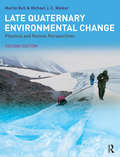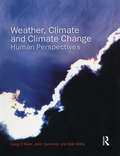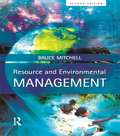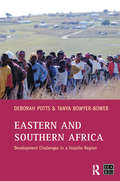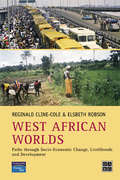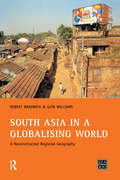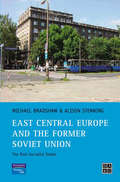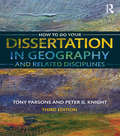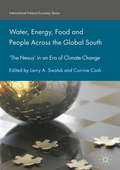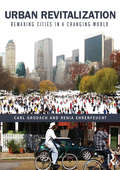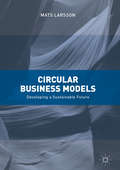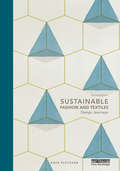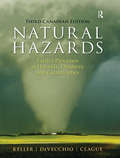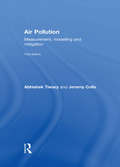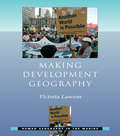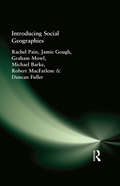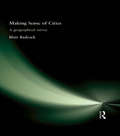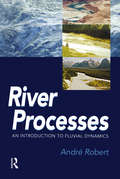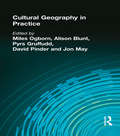- Table View
- List View
Late Quaternary Environmental Change: Physical and Human Perspectives
by Martin Bell M.J.C. WalkerLate Quaternary Environmental Change addresses the interaction between human agency and other environmental factors in the landscapes, particularly of the temperate zone.Taking an ecological approach, the authors cover the last 20,000 years during which the climate has shifted from arctic severity to the conditions of the present interglacial environment.
Weather, Climate and Climate Change: Human Perspectives
by Greg O'Hare John Sweeney Rob WilbyA timely and accessible analysis of one of the most crucial and contentious issues facing the world today – the processes and consequences of natural and human induced changes in the structure and function of the climate system.Integrating the latest scientific developments throughout, the text centres on climate change control, addressing how weather and climate impact on environment and society.
Weather, Climate and Climate Change: Human Perspectives
by Greg O'Hare John Sweeney Rob WilbyA timely and accessible analysis of one of the most crucial and contentious issues facing the world today – the processes and consequences of natural and human induced changes in the structure and function of the climate system.Integrating the latest scientific developments throughout, the text centres on climate change control, addressing how weather and climate impact on environment and society.
Resource and Environmental Management
by Bruce MitchellThis book does an exceptional job in giving an understanding of change, complexity, uncertainty and conflict as well as their linkages, including awareness of strategies, methods and techniques to handle them relative to resource and environmental management. The text enhances the reader's capacity to conduct practice and conduct research in resource and environmental management.
Resource and Environmental Management
by Bruce MitchellThis book does an exceptional job in giving an understanding of change, complexity, uncertainty and conflict as well as their linkages, including awareness of strategies, methods and techniques to handle them relative to resource and environmental management. The text enhances the reader's capacity to conduct practice and conduct research in resource and environmental management.
Eastern and Southern Africa: Development Challenges in a volatile region (Developing Areas Research Group)
by Debby Potts T.A.S. Bowyer-BowerA unique and comprehensive introduction to contemporary development issues in East and Southern Africa, and represents a significant departure from the often descriptive approach adopted by existing regional and development texts on African regions. Each contribution is carefully chosen to highlight the theoretical basis to development issues, and the practical problems of implementing development plans, in this vital subregion. Overall this produces comprehensive and balanced coverage of historical, economic, political and social issues. The twin issues of globalisation and modernisation give the book a clear focus.
West African Worlds: Paths Through Socio-Economic Change, Livelihoods and Development (Developing Areas Research Group)
by Reginald Cline-Cole Elsbeth RobsonWest African Worlds provides a critical assessment of social, economic and political change in Africa’s most populous and arguably most externally focused region. With an emphasis on globalisation and modernisation, case studies and commentary are integrated throughout to highlight the concerns and issues of the region.Enriched by an impressive mix of West African voices, this text combines theory and application with policy and practice to address socio-economic change, the pursuit of livelihoods, and development within West Africa.
South Asia in a Globalising World: A Reconstructed Regional Geography
by Bob Bradnock Glynn WilliamsA comprehensive introduction to the important economic, social and political processes and development issues in this extremely popular region. South Asia provides one of the world's most challenging development contexts and The authors take a different approach to most traditional development texts, making the latest research teacher friendly and presenting material in an accessible manner for non-specialists.
South Asia in a Globalising World: A Reconstructed Regional Geography
by Bob Bradnock Glynn WilliamsA comprehensive introduction to the important economic, social and political processes and development issues in this extremely popular region. South Asia provides one of the world's most challenging development contexts and The authors take a different approach to most traditional development texts, making the latest research teacher friendly and presenting material in an accessible manner for non-specialists.
East Central Europe and the former Soviet Union: The Post-Socialist States (Developing Areas Research Group)
by Michael Bradshaw Alison StenningA comprehensive introduction to the important economic, social and political processes and development issues in this increasingly popular area of study. Employing a groundbreaking thematic approach the book centres its discussion on the interrelation between contemporary development theories and continuing transition issues in this huge and complex region.
How To Do Your Dissertation in Geography and Related Disciplines
by Tony Parsons Peter G KnightThis book provides undergraduates with a step-by-step guide to successfully carrying out an independent research project or dissertation. The book addresses each stage of the project by answering the questions that a student is likely to ask as the work progresses from choosing the subject area and planning the data collection through to producing illustrations and writing the final report. Most undergraduates in geography and related disciplines are required to undertake individual projects as part of their degree course; this book is a source of constructive, practical advice. This new third edition continues the tradition of friendly, well-informed but informal support, and continues to focus on answering the specific questions that students typically ask at each stage of the project. The new edition brings the text completely up to date by taking into account changes within the discipline and changes in the ways that students work. New digital media, social networking, mobile technology, e-journals, anti-plagiarism software, ethics approval rules and risk assessments are among the issues that this new edition takes into account. The new edition also broadens the book’s appeal by extending its coverage of the wide range of different approaches to geographical research, with expanded coverage of qualitative research, Geographic Information Systems, and new approaches to research design in both physical and human geographies
Water, Energy, Food and People Across the Global South: ‘The Nexus’ in an Era of Climate Change
by Larry A. Swatuk Corrine CashThis collection critically engages the resource use nexus. Clearly, a nexus-approach to resource policy, planning and practice is essential if sustainable development goals are to be met. In particular, in an era of climate change, an integrated approach to water, energy and agriculture is imperative. Agriculture accounts for 70% of global water withdrawals, food production accounts for 30% of global energy use and a rising global population requires more of everything. As shown in this collection, scholars of resource development, governance and management are ‘nexus sensitive’, utilizing a sort of ‘nexus sensibility’ in their work as it focuses on the needs of people particularly, but not only, in the global South. Importantly, a nexus-approach presents academics and practitioners with a discursive space in which to shape policy through research, to deepen and improve understandings of the interconnections and impacts of particular types of resource use, and to critically reflect on actions taken in the name of the ‘nexus’.
Urban Revitalization: Remaking cities in a changing world
by Carl Grodach Renia EhrenfeuchtFollowing decades of neglect and decline, many US cities have undergone a dramatic renaissance. From New York to Nashville and Pittsburgh to Portland governments have implemented innovative redevelopment strategies to adapt to a globally integrated, post-industrial economy and cope with declining industries, tax bases, and populations. However, despite the prominence of new amenities in revitalized neighborhoods, spectacular architectural icons, and pedestrian friendly entertainment districts, the urban comeback has been highly uneven. Even thriving cities are defined by a bifurcated population of creative class professionals and a low-wage, low-skilled workforce. Many are home to diverse and thriving immigrant communities, but also contain economically and socially segregated neighborhoods. They have transformed high-profile central city brownfields, but many disadvantaged neighborhoods continue to grapple with abandoned and environmentally contaminated sites. As urban cores boom, inner-ring suburban areas increasingly face mounting problems, while other shrinking cities continue to wrestle with long-term decline. The Great Recession brought additional challenges to planning and development professionals and community organizations alike as they work to maintain successes and respond to new problems. It is crucial that students of urban revitalization recognize these challenges, their impacts on different populations, and the implications for crafting effective and equitable revitalization policy. Urban Revitalization: Remaking Cities in a Changing World will be a guide in this learning process. This textbook will be the first to comprehensively and critically synthesize the successful approaches and pressing challenges involved in urban revitalization. The book is divided into five sections. In the introductory section, we set the stage by providing a conceptual framework to understand urban revitalization that links a political economy perspective with an appreciation of socio-cultural factors in explaining urban change. Stemming from this, we will explain the significance of revitalization and present a summary of the key debates, issues and conflicts surrounding revitalization efforts. Section II will examine the historical causes for decline in central city and inner-ring suburban areas and shrinking cities and, building from the conceptual framework, discuss theory useful to explain the factors that shape contemporary revitalization initiatives and outcomes. Section III will introduce students to the analytical techniques and key data sources for urban revitalization planning. Section IV will provide an in-depth, criticaldiscussion of contemporary urban revitalization policies, strategies, and projects. This section will offer a rich set of case studies that contextualize key themes and strategic areas across a range of contexts including the urban core, central city neighborhoods, suburban areas, and shrinking cities. Lastly, Section V concludes by reflecting on the current state of urban revitalization planning and the emerging challenges the field must face in the future.Urban Revitalization will integrate academic and policy research with professional knowledge and techniques. Its key strength will be the combination of a critical examination of best practices and innovative approaches with an overview of the methods used to understand local situations and urban revitalization processes. A unique feature will be chapter-specific case studies of contemporary urban revitalization projects and questions geared toward generatingclassroom discussion around key issues. The book will be written in an accessible style and thoughtfully organized to provide graduate and upper-level undergraduate students with a comprehensive resource that will also serve as a reference guide for professionals
Circular Business Models: Developing a Sustainable Future
by Mats LarssonThis book explores the need to develop business strategies, organise and fund transformation projects and manage the transformation programme in order to further a circular economy. Circular Business Models outlines sustainable business models that can be used by companies to move transformation forward on a large scale. In addition to business models the book will cover and discuss a number of other factors necessary for a successful transformation, such as business and innovation strategy, entrepreneurship and change management. Including original interviews with circular economy practitioners, this book will be applicable to industries as diverse as manufacturing, food processing, transportation and mechanical engineering. Addressing the different challenges that meet circular economy visionaries, it outlines strategies and business models needed to gain momentum in these different sectors.
Circular Business Models: Developing a Sustainable Future
by Mats LarssonThis book explores the need to develop business strategies, organise and fund transformation projects and manage the transformation programme in order to further a circular economy. Circular Business Models outlines sustainable business models that can be used by companies to move transformation forward on a large scale. In addition to business models the book will cover and discuss a number of other factors necessary for a successful transformation, such as business and innovation strategy, entrepreneurship and change management. Including original interviews with circular economy practitioners, this book will be applicable to industries as diverse as manufacturing, food processing, transportation and mechanical engineering. Addressing the different challenges that meet circular economy visionaries, it outlines strategies and business models needed to gain momentum in these different sectors.
Sustainable Fashion and Textiles: Design Journeys
by Kate FletcherPraise for the previous edition: "[A] fascinating book." John Thackara, Doors of Perception "Provides the foundations for a radical new perspective." Ethical Pulse "At last a book that dispels the idea that fashion is only interested in trend-driven fluff: not only does it have a brain, but it could be a sustainable one." Lucy Siegle, Crafts Magazine ? Fully revised and updated, the second edition of Sustainable Fashion and Textiles: Design Journeys continues to define the field of design in fashion and textiles. Arranged in two sections, the first four chapters represent key stages of the lifecycle: material cultivation/extraction, production, use and disposal. The remaining four chapters explore design approaches for altering the scale and nature of consumption, including service design, localism, speed and user involvement. While each chapter is complete in and of itself, their real value comes from what they represent together: innovative ways of thinking about textiles and garments based on sustainability values and an interconnected approach to design. Including a new preface, updated content and a new conclusion reflecting and critiquing developments in the field, as well as discussing future developments, the second edition promises to provide further impetus for future change, sealing Sustainable Fashion and Textiles: Design Journeys as the must-buy book for fashion and textiles professionals and students interested in sustainability.
Sustainable Fashion and Textiles: Design Journeys
by Kate FletcherPraise for the previous edition: "[A] fascinating book." John Thackara, Doors of Perception "Provides the foundations for a radical new perspective." Ethical Pulse "At last a book that dispels the idea that fashion is only interested in trend-driven fluff: not only does it have a brain, but it could be a sustainable one." Lucy Siegle, Crafts Magazine ? Fully revised and updated, the second edition of Sustainable Fashion and Textiles: Design Journeys continues to define the field of design in fashion and textiles. Arranged in two sections, the first four chapters represent key stages of the lifecycle: material cultivation/extraction, production, use and disposal. The remaining four chapters explore design approaches for altering the scale and nature of consumption, including service design, localism, speed and user involvement. While each chapter is complete in and of itself, their real value comes from what they represent together: innovative ways of thinking about textiles and garments based on sustainability values and an interconnected approach to design. Including a new preface, updated content and a new conclusion reflecting and critiquing developments in the field, as well as discussing future developments, the second edition promises to provide further impetus for future change, sealing Sustainable Fashion and Textiles: Design Journeys as the must-buy book for fashion and textiles professionals and students interested in sustainability.
Natural Hazards: Earth's Processes as Hazards, Disasters, and Catastrophes
by Edward A. Keller John Clague Duane E. DeVecchioNatural Hazards focuses on hazards as the interface between humanity and its needs for space and resources, as well as on the ongoing geologic processes of Earth and features many new Canadian examples and discussions while retaining the best U.S. and international illustrations. The third Canadian edition strikes an ideal balance between the scientific and the human aspects of natural hazards, combining basic scientific principles within a solid social framework.
Air Pollution: Measurement, Modelling and Mitigation, Third Edition
by Jeremy Colls Abhishek TiwaryA one stop, comprehensive textbook, covering the three essential components of air pollution science. The Third Edition has been updated with the latest developments, especially the inclusion of new information on the role of air pollutants in climate change. The authors give greater coverage to the developing economies around the world where air pollution problems are on the rise. The Third Edition continues to cover a wide range of air quality issues, retaining a quantitative perspective. Topics covered include - gaseous and particulate air pollutants, measurement techniques, meteorology and dispersion modelling, mobile sources, indoor air, effects on plants, materials, humans and animals. Moving away from classical toxic air pollutants, there is a chapter on climate change and another on the depletion of stratospheric ozone. A special feature of this new edition is the inclusion of a fresh chapter on air pollution mitigation by vegetation, mainly its role in maintaining a sustainable urban environment. Recommended for upper-level undergraduate and postgraduate courses specialising in air pollution, both for environmental scientists and engineers. The new material included in the Third Edition extends its use by practitioners in consultancies or local authorities.
Air Pollution: Measurement, Modelling and Mitigation, Third Edition
by Jeremy Colls Abhishek TiwaryA one stop, comprehensive textbook, covering the three essential components of air pollution science. The Third Edition has been updated with the latest developments, especially the inclusion of new information on the role of air pollutants in climate change. The authors give greater coverage to the developing economies around the world where air pollution problems are on the rise. The Third Edition continues to cover a wide range of air quality issues, retaining a quantitative perspective. Topics covered include - gaseous and particulate air pollutants, measurement techniques, meteorology and dispersion modelling, mobile sources, indoor air, effects on plants, materials, humans and animals. Moving away from classical toxic air pollutants, there is a chapter on climate change and another on the depletion of stratospheric ozone. A special feature of this new edition is the inclusion of a fresh chapter on air pollution mitigation by vegetation, mainly its role in maintaining a sustainable urban environment. Recommended for upper-level undergraduate and postgraduate courses specialising in air pollution, both for environmental scientists and engineers. The new material included in the Third Edition extends its use by practitioners in consultancies or local authorities.
Making Development Geography
by Victoria LawsonMaking Development Geography is a timely new book which introduces readers to the major themes and debates in development geography. It argues cogently that the field is engaged in an ongoing process of reinventing itself as critical development geography, and highlights issues such as identity, globalization, social movements and sexuality. Readers are guided through the key concepts and developments of the last 50 years, surveying the themes of Keynesianism, Marxism and post-colonialism. At the same time, each chapter uses international examples to discuss important contemporary issues so that the real-world applications of theory can be understood.This enlightening book offers a comprehensive introduction to the fundamental debates for anyone with an interest in development issues.
Introducing Social Geographies
by Rachel Pain Jamie Gough Graham Mowl Michael Barke Robert MacFarlene Duncan Fuller`Introducing Social Geographies' is a major new text offering a comprehensive and up-to-date introduction to this important area of human geography. It presents a broad overview of social geography, clearly outlining the key theoretical and political positions, and making extensive use of examples to show how these frameworks can be used to analyse real social issues.The book is ideal for undergraduates first encountering social geography and includes topic overviews, summaries of key points, critiques, boxed case studies and suggestions for further reading.
Making Sense of Cities: A geographical survey
by Blair BadcockIn 2000, for the first time, a majority of the world's population was living in cities. The trend towards increasing urbanization shows no sign of slowing and the third millennium looks set to be an unprecedentedly urban one.'Making Sense of Cities' provides an up-to-date, vibrant and accessible introduction to urban geography. It offers students a sense of the patterns and processess of urbanization and the spatial organisation of cities, recognizing the significance of globalization, economics, politics and culture from a range of perspectives. Above all, it seeks to provide a relevant approach, inviting students to engage with competing theories of the urban and to assess them against the background of their own opinions and personal experience.Examples and case studies are drawn from a range of international settings, from San Francisco to Shanghai, Sydney to Singapore, giving a genuinely global coverage. The book is written in a fresh and engaging stlye, and is fully illustrated throughout. It is designed to appeal to any student of the urban and will be essential to students of geography, urban studies, town planning and land economy.
RIVER PROCESSES: An introduction to fluvial dynamics
by Andre RobertRiver Processes deals primarily with flow and sediment dynamics in alluvial channels. It emphasises water flows (basic principles and characterisation), fluvial sediment, processes of erosion and sediment transport, bedforms that result from flow-bed sediment interactions in sand and gravel, flow and sedimentary processes in curved, braided and confluent channels, as well as aquatic habits.River Processes provides a comprehensive synthesis of current knowledge about physical processes in alluvial channels, with an emphasis on the recent work on flow-bed-sediment transport interactions. It is intended primarily for undergraduate students interested in fluvial studies as part of physical geography, earth sciences, environmental sciences and ecology courses. The textbook is fully illustrated throughout with line drawings and photographs.
CULTURAL GEOGRAPHY IN PRACTICE
by Miles Ogborn Alison Blunt Pyrs Gruffudd David PinderCultural Geography in Practice provides an innovative and accessible approach to the sources, theories and methods of cultural geography. Written by an international team of prominent cultural geographers, all of whom are experienced researchers, this book is a fully illustrated guide to methodological approaches in cultural geography. In order to demonstrate the practice of cultural geography each chapter combines the following features:·Practical instruction in using one of the main methods of cultural geography (e.g. interviewing, interpreting texts and visual images, participatory methods)·An overview of a key area of concern in cultural geography (e.g. the body, national identity, empire, marginality)·A nuts and bolts description of the actual application of the theories and methods within a piece of researchWith the addition of boxed definitions of key concepts and descriptions of research projects by students who devised and undertook them, Cultural Geography in Practice is an essential manual of research practice for both undergraduate and graduate geography students.
